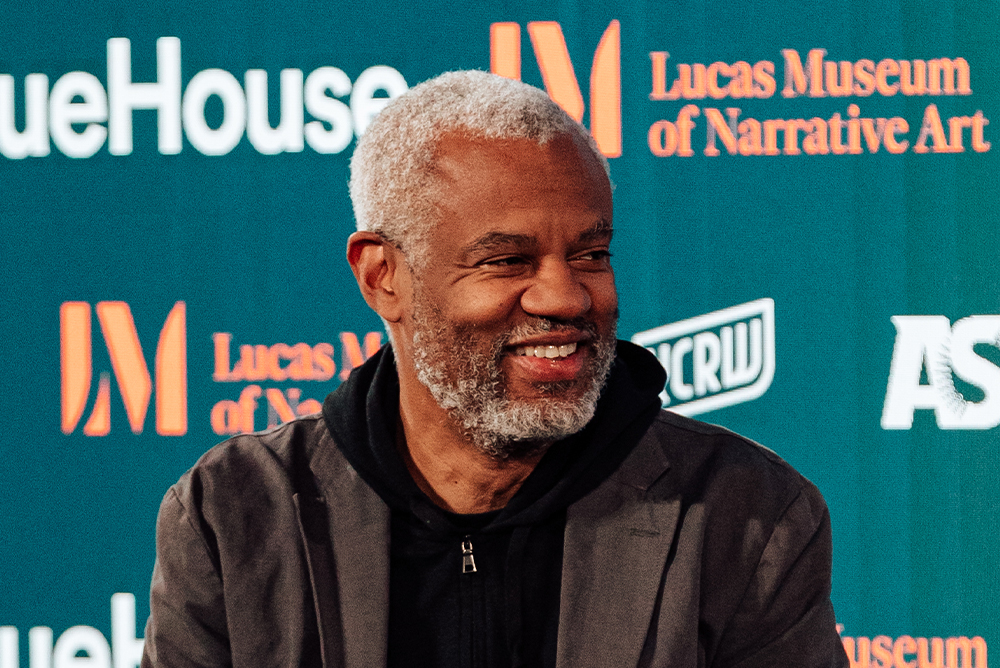
Photo by Chad Brady.
Hamza Walker became LAXART’s second director after 22 years as curator and director of education at the Renaissance Society in Chicago. Before joining the Zócalo event “What Is the Value of Art?”—presented in partnership with NeueHouse, KCRW, and Lucas Museum of Narrative Art—he joined us in the green room to talk comics, Old Bay seasoning, and who would paint his portrait.
As someone who once curated a show on teen paranormal romance, we have to know: what’s your favorite work in that genre?
My daughter is a voracious reader, and so whatever my skirmishes were with that literature was through her. I read one of The Hunger Games books—I guess it would have been the first one—and enjoyed it.
What did you like to read growing up?
Comic books, science fiction—I can’t imagine myself without having had those things growing up. The Avengers, Thanos—that whole what is considered the MCU. I was a real comic head, so I liked it all. Swamp Thing—like the first 10 issues of the Swamp Thing? Gold. X-Men starting at issue, like, 101 up through, I don’t know, 145? All that stuff.
Do you still read comics today?
I feel like movies have ruined it, in some sense. Like technically, formally—like the panel, the sequencing, or whatever. There was a moment when comics were cinematic, and when they veered toward the cinematic—I’m thinking of like Neal Adams, great moves, in terms of the arrangement of the panels or breaking down the panels and the page layout and stuff like that. Movies have reduced the comic book to just storyboards. You used to have to use your imagination. [Comic books] were catalysts for the imagination.
You grew up in Baltimore. Do you have a favorite thing to put Old Bay on?
If I taste Old Bay outside of crabs, I can’t have Old Bay. Old Bay is the flavor of crabs to me. It’s put on crabs. It has no other purpose or reason for being.
You’ve spoken about wanting to move to L.A. since you graduated college. What first drew you here?
There’s an ebb and flow of L.A. as an art center, and that seemed to be a real moment, where L.A. was in the spotlight. I knew about it through contemporary art, and at that time, Mike Kelley was the artist whose work I was drawn to, who was based here in L.A. And CalArts, ArtCenter—those places had become mythic for me, in terms of the faculty that was there. So it just seemed like a real dynamic place. That was the draw.
What do you think is the most L.A. thing about you?
Sometimes people say, “You seem like you could be from L.A.” And I’m like, I don’t know what that means! I lived in the Midwest for 32 years, but I’m from the East Coast. Nothing’s gonna change that. It is what it is. It’s how not L.A. I am that’s only become apparent to me upon moving here. Californians are a different breed.
What’s the most important piece of art you own? And what makes it valuable to you?
It all has value to me because almost all the work I own is from friends, former students, artists I’ve worked with. That’s the importance of all of it in terms of what it represents. I can’t think of the artwork I own as independent from the people who are in my life.
If you could choose an artist to paint your portrait, who would it be, and why?
If I had to do it all over again, which I probably will, and since he’s already done my portrait twice, why not do it over again? Too much of a good thing is wonderful. Henry Taylor. He’s got a good thing going. If it ain’t broke!



